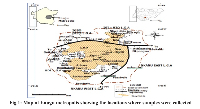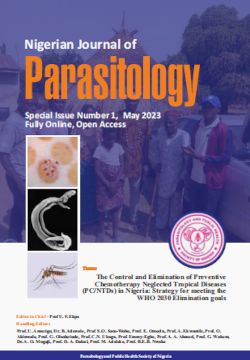Occurrence of Intestinal Parasites in Effluent Slurries from Piggeries in Enugu, Nigeria
DOI:
https://doi.org/10.4314/njpar.v45i1.20%20Keywords:
Enugu, Pigs, effluent slurries, Intestinal parasites, OccurrenceAbstract
There is a growing concern for pig parasites as a bottleneck for low productivity and reduction in the market value of pork meat. Parasite infection is a common problem in organic pig production, which can threaten the food safety of pork products, and cause economic losses to organic farmers. Hence assessing various channels by which these diseases can be transmitted is very important. This study was carried out to ascertain the distribution of intestinal parasites in slurries from a piggery in Enugu, South East Nigeria. In this study, a total of 100 pooled samples were examined from 5 farms. These samples were analyzed using the formol ether concentration technique. Out of 100 pooled samples examined, 67% of the samples were positive for intestinal parasites. The occurrence rate of the different parasites encountered was: Ascaris suum (11.9%), Trichuris suis (10.4%), Taenia solium (7.6%), Strongyloides ransomi (3.0%), Schistosoma sp.(3.0%), Entamoeba suis (28.6%), Entamoeba polecki (1.5%) and Ancylostoma duodenale (20.9%). This study is of utmost importance as findings
from this study highlight the presence of various intestinal parasites in effluent slurries. There are prospects of the spread of these slurries from piggeries into the surrounding environment (which includes residential areas, commercial areas and even farmlands). Deworming of pigs to reduce parasite load is highly advocated.
References
Nwafor, I. C., Roberts, H., and Fourie, P. (2019). Prevalence of gastrointestinal helminths and parasites in smallholder pigs reared in the central Free State Province, Onderstepoort. Journal of Veterinary Research, 86(1):a1687. DOI:10.4102/ojvr.v86i1.1687.
Seid, A., and Abebaw, G. (2008).Production systems dynamism and parasitic interaction of swine in and around Holetta. Ethiopia. Ethiopian Veterinary Journal, 14(1):71–81.DOI:10.4314/EVJ.V14I1.63870
Omoruyi, Z., and Agbinone, I. (2020). Gastrointestinal parasites among swine bred in Edo State, Nigeria. African Journal of Clinical and Experimental Microbiology, 21(4):349–353.DOI:10.4314/AJCEM.V21I4.12
Li, Y. Z., Hernandez, A. D., Major, S., and Carr, R. (2022). Occurrence of Intestinal Parasites and Its Impact on Growth Performance and Carcass Traits of Pigs Raised Under Near-Organic Conditions. Frontiers in Veterinary Science, 9,911561.DOI:10.3389/fvets.2022.911561
Lindgren, K., Cunnarsson, S., Hoglund, J., Lindahl, C., and Roepstorff, A. (2020). Nematode parasites eggs in pasture soils and pigs on organic farms in Sweden. Organic Agriculture, 10, 289 – 300. DOI:10.1007/s13165-019-00273-3
Karaye, G. P., Iliyasu. D., Dogo, A. G., and Madu, H. K. (2016). Prevalence of Swine Gastrointestinal Parasites in Four Selected Local Government Areas of Nasarawa State, Nigeria. International Journal of Livestock Research, 6(1): 21-26.DOI:10.5455/IJLR.20151217082323.
Gowda, C. K., Pattalakshmamma, G. C., D'Souza, P. E., Mamatha, G. S, and Chandranaik, H. M. (2018). Survey of gastrointestinal parasites of pigs slaughtered in Bengaluru. Journal of Veterinary Parasitology, 32:23-37.DOI:10.5958/0974-0813.2018.00005.0.
Kochanowski, M., Karamon, J.,Dabrowska, J., Dors, A., CzyzewskaDors, E and Cencek, T. (2017). Occurrence of intestinal parasites in pigs in Poland – the influence of factors related to the production systems. Journal of Veterinary Research, 61(4), 459–466. DOI:10.1515/jvetres-2017-
Jankowska-Makosa, A., and Knecht, D. (2015). The influence of endoparasites on selected production parameters in pigs in various housing systems. Research in Veterinary Science, 100, 153–160. DOI: 10.1016/j.rvsc.2015.04.002.
Ozvari, L. (2017). Production losses of parasitisms in swine. Literature Review Magyar Allatorvosok Lapja.139:17–25.
Dey, T. R., Dey, A. R., Begum, N., Akther, S., and Barmon, B. C.(2014). Prevalence of endoparasites of pig at Mymensingh,Bangladesh. Journal of Agriculture and Veterinary Science, 7(4 ): 31 – 38. DOI:10.9790/2380-07433138.
Marufu, M. C. M., Chanayiwa, P.,Chimonyo, M., and Bhebhe, E. (2008). Prevalence of gastro-intestinal nematodes in Mukota pigs in a communal area of Zimbabwe. African Journal of Agricultural Research, 3:91–95. (article1380878969_Marufu et al.pdf (academicjournals.org))
Nsoso, S. J., Mosala, K. P., Ndebele, R. T. and Ramabu, S. S. (2000). The prevalence of internal and external parasites in pigs of different ages and sexes in Southeast District, Botswana, Onderstepoort. Journal o f Veterinary Research, 67: 217–220.(32nsoso2000.pdf (up.ac.za)
Obonyo, F. O., Maingi, N., Githigia, S. M. and Nganga, C. J. (2012). Prevalence, intensity and spectrum of helminths of free range pigs in Homabay District, Kenya. Livestock Research for Rural Development24(3):47–49. (https://api.semanticscholar.org/CorpusID: 90896850).
Sowemimo, A. O., Asaolu, S. O, Adegok, F. O. and Ayanniyi, O. O. (2012).Epidemiological survey of gastro-intestinal parasites of pigs in Ibadan, Southwest Nigeria, Journal of Public Health and Epidemiology, 4: 294 – 298. (article1379672972_Sowemimo et al.pdf (academicjournals.org)
Tidi, S. K., Ella, F. A., and Ella, A. B. (2011).Prevalence of Gastro-Intestinal Parasites of Pigs in Jos, Plateau State, Nigeria. Nigerian Journal of Parasitology, 32(1):37-40.DOI:10.4314/NJPAR.V32I1
Tumusiime, M., Ntampaka, P., Niragire, F., Sindikubwabo, T., and Habineza, F(2020). Prevalence of Swine Gastrointestinal Parasites in yagatare
District, Rwanda. Journal of Parasitology Research, 8814136. DOI:10.1155/2020/8814136
Li, Y. Z., Hernandez, A., Carr, R., Major, S., and DeWitte, D. (2020). Parasiteprevalence and faecal egg count on organic pig farms. J Anim Sci, 98:463. DOI:10.1093/jas/skaa054.385.
Abonyi, F., and Njoga, E. (2019). Prevalence and determinants of gastrointestinal parasite infection in intensively managed pigs in Nsukka
agricultural zone, Southeast, Nigeria. Journal of Parasitic Diseases, 44(1) DOI:10.1007/s12639-019-01158-8.
Nwanta, J. A., Shonyinka, S. V. O., Chah, K. F., Onunkwo, J. O., Onyenwe, I. W., Eze, J. I., Iheagwam, C. N., Njoga, E. O., Onyema, I., Ogbu, K. I., Mgbegbu, E. C., Nnadozie, P. N., Ibe, E. C and Oladimeji, K. T. (2011). Production characteristics, disease prevalence, and herd-health management of pigs in Southeast Nigeria. Journal of Swine Health and Production, 19:331-39. (aasv.org/shap/issues/v19n6/v19n6p331.pdf
).
Njoga, E. O., Onunkwo, J. I., Okoli, C. E., Ugwuoke, W. I., Nwanta, J. A. and Chah, K. F. (2018). Assessment of antimicrobial drug administration and antimicrobial residues in food animals in Enugu State, Nigeria. Tropical Animal Health and Production, 50(4):897–902. DOI: 10.1007/s11250-018-1515-9.
Bryon, L. B and Michael, W. D. (2000). Pfizer Atlas of Veterinary Clinical Parasitology. The Gloyd Group Inc.Wilmington. Delaware.((pdf) Pfizer Atlas of Veterinary Clinical Parasitology | Cristóbal Morteo Tenorio - Academia.edu)

Downloads
Published
How to Cite
Issue
Section
License
Copyright (c) 2024 Nigerian Journal of Parasitology

This work is licensed under a Creative Commons Attribution-NonCommercial-NoDerivatives 4.0 International License.




